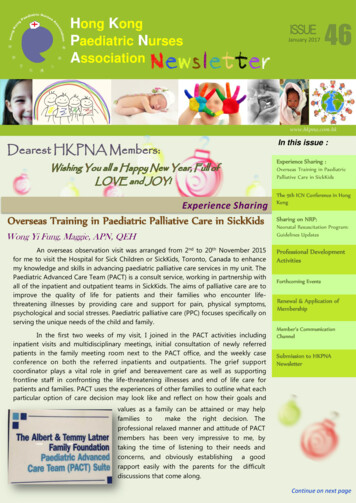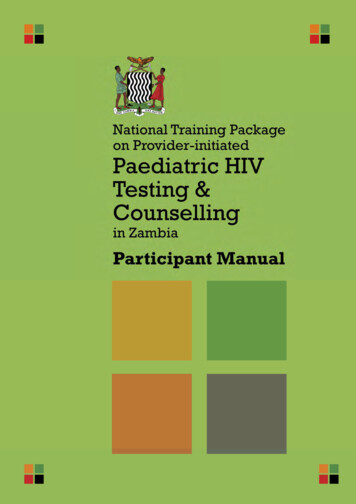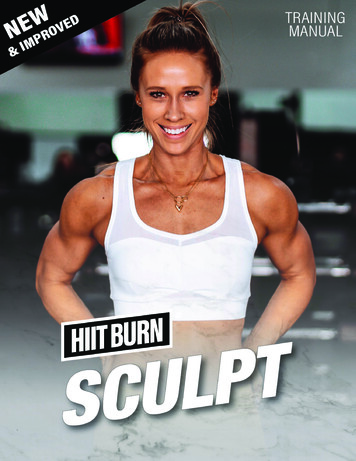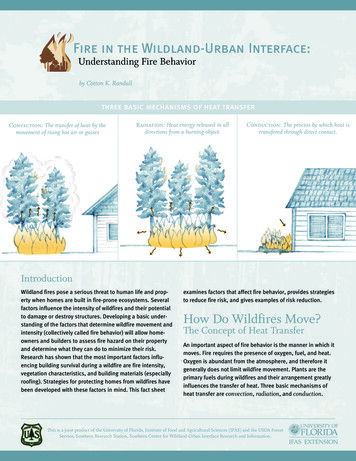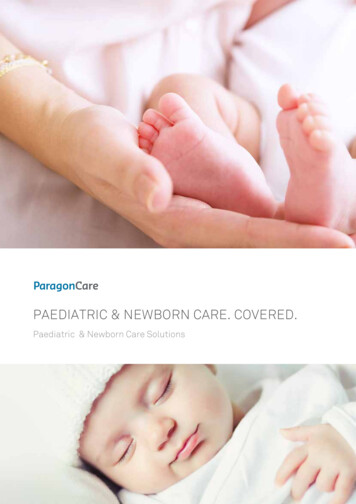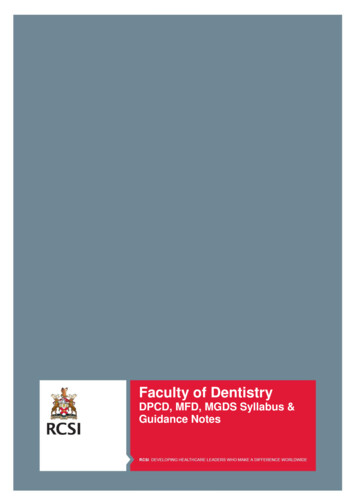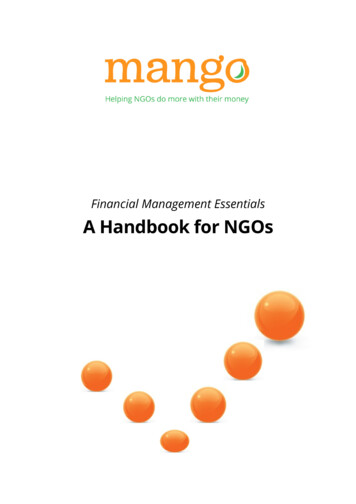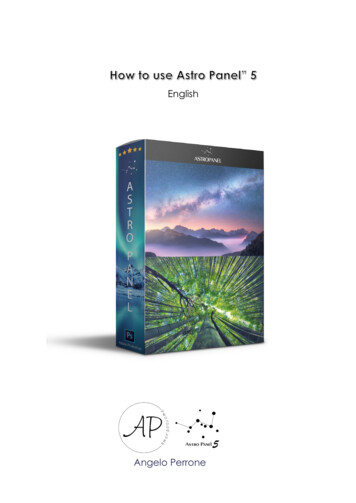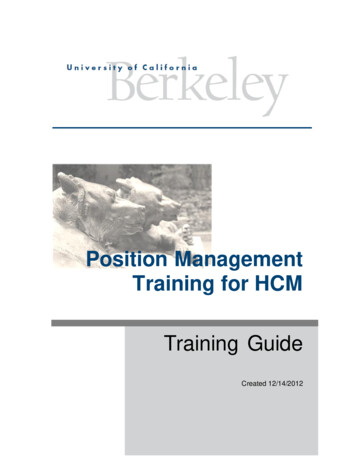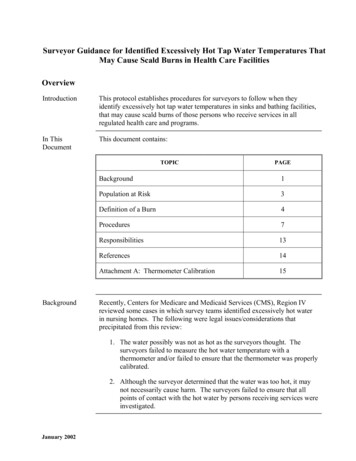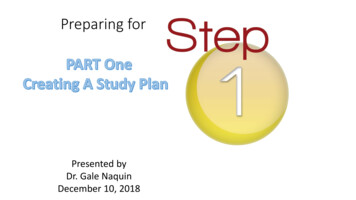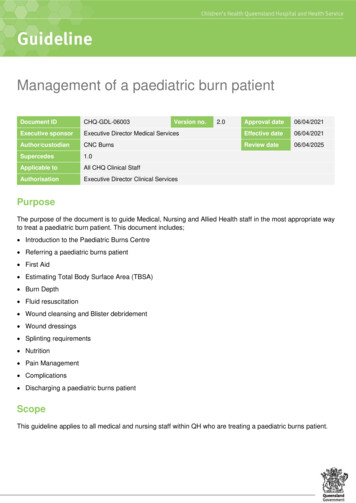
Transcription
Management of a paediatric burn patientDocument IDCHQ-GDL-06003Executive sponsorVersion no.2.0Approval date06/04/2021Executive Director Medical ServicesEffective date06/04/2021Author/custodianCNC BurnsReview date06/04/2025Supercedes1.0Applicable toAll CHQ Clinical StaffAuthorisationExecutive Director Clinical ServicesPurposeThe purpose of the document is to guide Medical, Nursing and Allied Health staff in the most appropriate wayto treat a paediatric burn patient. This document includes; Introduction to the Paediatric Burns Centre Referring a paediatric burns patient First Aid Estimating Total Body Surface Area (TBSA) Burn Depth Fluid resuscitation Wound cleansing and Blister debridement Wound dressings Splinting requirements Nutrition Pain Management Complications Discharging a paediatric burns patientScopeThis guideline applies to all medical and nursing staff within QH who are treating a paediatric burns patient.
IntroductionThe Paediatric Burns Centre (PBC) provides the only specialist dedicated paediatric burns centre inQueensland according to the Australian and New Zealand Burns Association (ANZBA) Guidelines. OtherBurns Units in Queensland (including Townsville Hospital and The Gold Coast University Hospital) are onlyable to provide treatment for small to medium size burns in children.The PBC provides inpatient care (acute and rehabilitation), together with ambulatory and outreach care, forany child referred with a burn injury irrespective of size or depth.The PBC also has a burns theatre. This theatre operates twice weekly for dressing changes, microneedling,laser therapy and ranging under general anaesthetic.Currently we treat over 1000 new burns per year. The most common mechanisms of burns reviewed withinthe unit are: Scalds- tea/coffee, kettles, baths, noodles. Contact – iron, hair straighteners, exhausts, campfires. Friction – treadmills, MVA. Flame –kerosene, petrol, house fires.Directed by Professor Roy Kimble, our multidisciplinary team consists of Surgical Consultants, Medical,Nursing, Allied Health, psychologists, administration and research staff.We care for acute, post-acute and reconstruction burns from newborn through to adolescents, until they arethen transitioned to the adult Burns Centre at the Royal Brisbane and Women’s Hospital if required.While burns are predominately our primary focus, we also consult and advise on other conditions including; Meningococcal septicemia. Epidermylosis Bullosa. Scalded Skin Syndrome. Steven Johnson Syndrome. Intravenous Extravasations. Graft vs Host. Neonatal Burns.CHQ-GDL-06003 Management of a paediatric burn patient-2-
Burns Outpatient provides Consultant led clinics Monday - Friday (except public holidays). All clinics areattended by Social Work, Occupational Therapy and Physiotherapy.The PBC multidisciplinary team includes: 5 Paediatric Surgery Consultants. Physiotherapists. Burns Clinical Nurse Consultant. Music Therapy. Burns Clinical Nurse. Dietician. Burns Registered Nurse. School teacher. Social Worker. Research. Occupational Therapists. Child and Youth Mental Health.Referring a burnThe PBC offers a 24/7 referral service. For a referral coming from regional QLD, an email referral service isavailable. Criteria for referring to our service is based on the Australian New Zealand Burns Associationtransfer guidelines for Burns Service referral. For those burns located in the Mackay region and furthernorth, please refer to Townsville Hospital first. For those burns located in the Gold Coast region andfurther south, please refer to Gold Coast University Hospital first. If they are unable to care for thepatient, then please follow the information below to refer to QCH.To refer a patient to the PBC; Contact the Burns Registrar on call via switch (07) 3068 1111. Complete referral form via link -advice/burns/ Further correspondence can be sent via our generic email address burns-opd@health.qld.gov.au. Attach any photos to this email if possible. If advised that the patient can be treated locally, continue to contact the burns Registrar at each dressingchange to update progress and send through photos to above email address.All paediatric patients should be referred to the PBC. However they may not physically be required to attendthe QCH. If treatment can be managed in the local area then this is the preferred treatment.ALERTPatient referrals will not be accepted unless completed referral form is sent.Telehealth Emergency Support Unit (TEMSU) is available to improve access and provide support toemergency specialists from rural areas. TEMSU can be used for services such as: advice for acute burns;dressing instructions; debridement advice. TEMSU will link the rural area with the Burns Specialists within theQueensland Children’s Hospital.To contact TEMSU please call 1800114414.CHQ-GDL-06003 Management of a paediatric burn patient-3-
First AidRecent studies have enabled detailed recommendations for appropriate first aid in burns treatment. Theapplication of cold water to the wound has multiple benefits including pain relief, decreased cell damage,improved wound healing and scar formation 1,2.Steps for providing adequate first aid:(1)(2)(3)Stop:(a)Stop drop and roll.(b)Remove all heat source including clothes, nappies, jewellery.Cool:(a)Running cold tap water for 20mins.(b)Do NOT use ice.Cover:(a)Use cling film to cover wound.Helpful links for further information on first aid in w.coolburns.com.au/first-aid-for-burnsALERTEnsure that patient is asked ‘how long’ has first aid been applied prior to admission tohospital. If less than 20mins, place under cool running water until a total of 20min hasbeen completed.Ensure unburnt areas are kept covered and warm to prevent hypothermiaFirst aid is effective for up to 3hrs post burnsEstimating TBSATotal Body Surface Area (TBSA) is to be undertaken on admission to Emergency department. While thereare multiple techniques and apps that can assist with this calculation, the following are recommended: Lund and Browder form (Appendix 1). This is more accurate when estimating TBSA in paediatric patients. ITIM app, designed by NSW Institute of Trauma and Injury Management. This app includes many differentcalculators including estimating TBSA and Fluids Resuscitation. For small areas, e.g. the palm (including fingers), of the patient, equates to approximately 1% of thepatient’s body surface.Superficial burns (Erythema only) are not included in estimating burn TBSA.CHQ-GDL-06003 Management of a paediatric burn patient-4-
Burns DepthEstimating burn depth allows us to further plan treatments for our patients and likelihood of scarring.Terminology has changed over the years with 1st, 2nd and 3rd degrees no longer used.Superficial Previously called erythema. Involve only the epidermis. These burns are not included in estimating TBSA. Characterised by redness that slowly disappears, no blistering present.Superficial Partial thickness Involve both the epidermis extending into the dermis. Characterised by blistering skin, blanches when touched. Often most painful burns.Deep dermal Partial thickness Involves the epidermis and further into the dermis. Can often have areas of blistering with other pale areas. Some areas may blanche however deeper areas often will not. Can often get areas that look ‘cherry red’ in colour, while it may look nice and pink these areas generallywill not blanch and are caused by red bloods cells that have extravasated.Full thickness Involves the epidermis, the dermis and often extends into subcutaneous fat. These appear white in colour and can be quite thick to touch or leathery. Generally has no sensation.ALERTBurns can often change appearance within the first 72 hrs, especially scald burns. It ishard to determine depth until after the first dressing change has occurred.CHQ-GDL-06003 Management of a paediatric burn patient-5-
Fluid ResuscitationThe systemic result following a burn injury causes increased capillary permeability resulting in fluid shiftinginto the interstitial space around the burn. This can occur up to around 24 hrs. Fluid Resuscitation is requiredto replace this large fluid loss over the first 24hrs. According to ANZBA guidelines, fluid resuscitation shouldbe administered if TBSA. 10% in under 18mth old. 15% in over 18mth old.The Parkland formula is recommended (Appendix 2), with half given over the first 8 hrs from the time ofinjury. The remaining half is given over the following 16hrs.Maintenance fluid should also be commenced BUT must be on a separate line and NOT combined with fluidresuscitation.For large burns ( 25%), Albumin has been shown to decrease total amount of fluids required. Albuminshould not be used within the first 6hrs of sustaining a burn injury. After this time, Albumin should be given asa 50:50 ratio to the resuscitation crystalloid.ALERTAll patients commenced on fluid resuscitation should have an IDC inserted. Aim foroutput of 1ml/kg/hr.All patients commenced on fluid resuscitation should have an NGT inserted. Feedsshould be commenced at 10ml/hr and slowly increased to full feeds within 24hrs ofsustaining a burn injury. Dietician review is required.Wound cleansing and Blister debridementOnce first aid has been completed, the wound can be cleaned and blisters debrided in preparation fordressing application. Prior to commencing procedure, please ensure that adequate pain relief has beenadministered and appropriate time has elapsed for medication to become effective.To cleanse the burn wound, apply QV wash to a damp cloth. Wash wound then rinse with a clean cloth toremove soap residue. Rinse burn area using a Chlorhexidine Gluconate solution. Dilute 10ml ChlorhexidineGluconate 5 % with 500ml water.Blisters should be debrided prior to application of dressing. To do this, use a cloth to wipe over wound andremove surrounding tissue. If blisters are quite thick and unable to be wiped away, use a pair of sterilescissors to remove top of blister. Avoid using forceps or scissors as this can induce anxiety and stress for apaediatric patient.Any remaining skin can be removed at next dressing change.Cover wound with cling wrap after debridement.ALERTDO NOT use needles to express blisters. There is a high risk of sustaining a needle stickinjury.CHQ-GDL-06003 Management of a paediatric burn patient-6-
Wound DressingsWhile there are many different dressings on the market that may be suitable for treating burns, the dressingsused within our department are evidence based and most suitable for the paediatric population.Once the wound has been cleaned, follow the flow chart (Appendix 4) to determine the most appropriatedressings choice. Once dressing has been chosen, please refer to the following video and standards forcorrect application.Acticoat StandardMepilex AgBurns- Hand DressingsHow to apply a burns dressings video- https://vimeo.com/153986604. Password: burns-opdHow to attend a burns dressing fingers, toes and ears video- a0e64213Patients that require fluid resuscitation should be considered for dressing changes under a generalanaesthetic initially.ALERTFlamazine is not to be used in paediatric patients. If Mepilex Ag or Mepitel and Acticoatare not available, then patient must be transferred to QCH for further treatment.Splinting requirementsSome burns may require review by the Occupational Therapist on call. These may include: Deep partial or full thickness burn injury crossing the flexor surface of a joint, placing joint at risk ofcontracture. Immobilisation by use of a splint is required to ensure safe position or integrity of underlying bodystructures and function, and suitable short-term alternatives (e.g. armboard, positioning devices andbandaging techniques) are not available or considered suitable. Significant oedema present limiting function or contributing to vascular insufficiency as indicated by poorcapillary return and cool to touch distal limb. Continuation of occupational therapy intervention commenced during business hours is required tomaintain current level of patient function or to minimise risk of irreversible harm, as determined byOccupational Therapist in conjunction with a medical Consultant.Occupational Therapy provides a Burns On-Call Service at QCH between 8am-5pm on weekends and publicholidays. Children identified as requiring Occupational Therapy input are to be determined by aBurns/Surgical Consultant or Registrar and meeting criteria outlined in the Occupational Therapy Burns OnCall procedure.ALERTIf splint is required and Occupational Therapists are unavailable, armboards are NOTappropriate and patient should be admitted until review by Occupational Therapist isavailable.CHQ-GDL-06003 Management of a paediatric burn patient-7-
NutritionNutrition is an important facet of burns care especially within the paediatric burns population. Children aremore vulnerable to the metabolic demands and consequences of a burn injury compared to adults3. Theyhave limited fat and lean body reserves, increased body surface area in relation to weight, and extra need fornutrients for growth and development4.All children requiring Burns Fluid Resuscitation should have a NGT inserted and commenced on enteralfeeds. A dietician review is required to ensure appropriate formula is used.Some children not requiring fluid resuscitation may require admission to ward to monitor oral intake. It iscommon for children who have sustained burns involving the face to have decreased oral intake over thefollowing days. They may also require insertion of a NGT if oral intake is poor.For more information regarding nutritional requirements of Burns patient please refer to NutritionalManagement of Paediatric Burns Patients.Pain ManagementPain management is an integral part of Burns care. No procedures should be undertaken without adequatepain relief and constant reassessing of the patient. It has been proven that there is a correlation betweenpain, stress, anxiety and their effect on burn wound re-epithelialisation.Pain relief does not have to be just pharmaceutical. It is important to have non pharmaceutical, ageappropriate devices available for the children prior to commencing the procedure. Such items include: Bubbles. Toys. TV, DVD. Music Therapist. Breast Feeding.We have distinguished certain burns that tend to require greater amounts of pain relief during dressingprocedures. These include: Circumferential burns. Contact burns from hot coals. Burns 5%. Patients suffering anxiety. Previous distressing dressing changes.For these patients we will progress them onto our Burns Procedural Pain. Please ensure you have adequateMedical Staff available when undertaking these procedures and consult with your hospital guidelines todetermine the most appropriate medication and administration route.CHQ-GDL-06003 Management of a paediatric burn patient-8-
ComplicationsEscharotomyCirculation may become impaired in circumferential burns of the limbs and torso due to increased oedema. Inthe first instance the limbs should be elevated to reduce swelling and closely monitored for changes in: Colour. Capillary return. Skin temperatureIf this occurs, an escharotomy may be required. This is an emergency procedure and consultation with theBurns Surgeon on call is required5.ALERTAn escharotomy should be anticipated prior to the loss of pulses and numbness.Toxic ShockToxic Shock Syndrome (TSS) is a severe systemic illness which can cause death. While it is very rare, TSSis more common in children under the age of 4yr with skin loss due to the fact they have not developed theantibodies to the toxins6.TSS is characterised by: Shock. Pyrexia. erythematous rash. diarrhoea and vomiting. lethargy and irritability.Treatment for TSS can include: Intravenous fluids. Intravenous antibiotics. Intravenous immunoglobulin (IVIG).While TSS is not common, if you have a patient exhibiting similar signs, TSS must be considered. If you havenot already referred the patient to a Burns Specialist, this should occur urgently.CHQ-GDL-06003 Management of a paediatric burn patient-9-
Discharging a burnFor small burns, they can often be treated as outpatients and only return to the hospital once or twice a weekfor dressing changes and review by the Consultants. If the patient has adequate pain relief and there is noconcern regarding the burn, mechanism or attendance, they may be suitable for discharge home.Discharge information should be provided to the family. This can include the following fact sheets:Acticoat care- s/chifs/chifs-burn-acticoat-care.pdfMepilex Ag care- s/chifs/chifs-burn-mepilex.pdfEnsure appointment has been organised for review at the PBC within the next 3 days.For those patients from rural areas, Telehealth follow up can be arranged. This will be organised throughQCH Telehealth Service.ALERTCircumferential burns should not be discharged within first 24hrs.ConsultationKey stakeholders who reviewed this version: Director Paediatric Surgery, Urology, Burns CN Burns CNC BurnsDefinition of termsTermMepilexAgTMActicoatTMDefinitionSourceIs a trade mark product of Molnlycke Health Carewww.molnlycke.com.auIs a trade mark product of Smith & NephewSmith & Nephew – AustraliaReferences and suggested reading1. Cuttle, L., Pearn, J., McMillan, J,R. & Kimble, R.M. (2009). A review of first aid treatments for burn injuries. Burns, 35(6), 768-775. doi:10.1016/j.burns.2008.10.0112. Cuttle, L., Kravchuk, O., Wallis, B., & Kimble, R.M (2009) An audit of first-aid treatment of pediatric burns b013e3181bfb7d13. D’Cruz, R., Martin, H. C., & Holland, A. J. (2013). Medical management of paediatric burn injuries: Bestpractice Part 2. Journal of Paediatrics and Child Health. 49(9), E397-E404. Retrieved October 27,2016 .2013.49.issue-9/issuetocCHQ-GDL-06003 Management of a paediatric burn patient- 10 -
4. Chan, M.M., Chan, G. M. (2009). Nutritional therapy for burns in children and adults. Nutrition. 25(3), 7080044625. Children’s Health Queensland Hospital and Health Service, (2016). Paediatric Trauma Service: Trauma Manual (8thed.). Brisbane: Queensland Government.6. Women’s and Children’s Hospital (2010). Guidelines for the Management of Paediatric Burns. divisions/psurg/burns/documents/burns guidelines.pdfGuideline revision and approval historyVersion No.Modified byAmendments authorised byApproved by1.0CNC BurnsExecutive Director Medical ServicesExecutive Director Hospital Services2.0CNC BurnsNursing Director, Division of SurgeryExecutive Director Nursing ServicesCNC BurnsChief of SurgeryExecutive Director Medical Services31/08/20173.002/02/2021KeywordsBurns, paediatric, wounds, dressings, first aid, Acticoat, Mepilex Ag, 06003AccreditationreferencesNSQHS Standards (1-8): 1 Governance for Safety and Quality in Health ServiceOrganisations, 2 Partnering with Consumers, 3 Preventing and Controlling HealthcareAssociated InfectionsISO 9001:2015 Quality Management Systems: (4-10)CHQ-GDL-06003 Management of a paediatric burn patient- 11 -
Appendix 1: Lund and BrowderCHQ-GDL-06003 Management of a paediatric burn patient- 12 -
Appendix 2:Fluid Resuscitation guidelineThe modified Parkland Hospital Formula for burns resuscitation is used within the Pegg Leditschke Children’sBurns CentreFluid Resuscitation is required for: Any burn 10% in an infant 0-18mth Any burn 15% in a child 18mth and olderFluid Resuscitation Formula3-4mL Hartmanns’ Solution x Body Weight(kg) x Area of Burn (TBSA)PlusMaintenance Fluid of Hartmanns and 5% DextroseFluid Resuscitation Formula (24hr) First half of total volume given over first8hrs from time of injurySecond half given over remaining 16hoursMaintenance Formula100ml/kg up to 10kg50ml/kg for each kg between 10-20kg20ml/kg for each kg over 20kgIDC must be inserted for all children receiving fluid resuscitationAim for 1ml/kg/hr of urine outputNGT to be inserted for all children receiving fluid resuscitationCommence at 10ml/hr and titrate with maintenance fluid. Dietician to be notifiedNote: This is a guideline only and should be used for initial assessment. Fluid resuscitation should bereassessed hourly for effectiveness and altered accordinglyFor large burns ( 25%), Albumin has been shown to decrease total amount of fluids required. Albuminshould not be used within the first 6hrs of sustaining a burn injury. After this time, Albumin should be given asa 50:50 ratio to the resuscitation crystalloidCHQ-GDL-06003 Management of a paediatric burn patient- 13 -
Appendix 3: Chlorhexidine CalculationsAmount of Chlorhexidine Gluconate 5% added to water to maintain concentration of 0.1%.Small size disposable bowl: ½ full 500mls 10 mls Chlorhexidine GluconateRound disposable paper bowl: ¾ full 2L 40 mls Chlorhexidine GluconateBath water: 10cm 65 Litres 1.3 Litres Chlorhexidine GluconateBath water: 15 cm 110 litres 2.200 Litres Chlorhexidine GluconateFormula for CalculationC1 V1 C2 V2Concentration Stock x Volume Concentration Final x volume finalEg.C1 Chlorhex Stock 5%Final volume 2000mlFinal concentration 0.1%5% x V1 0.1% x 2000ml5%V1 40 mlsCHQ-GDL-06003 Management of a paediatric burn patient- 14 -
Appendix 4: Dressing flowsheetTBSASPT-DPTFTUnclean first aidChild unwellTotal body surface areaAll partial thickness burns(superficial to deep partial)Full thicknesse.g. water from creek/river,bore/untreated/tank water, dirty waterURTI, viral illness, etcCHQ-GDL-06003 Management of a paediatric burn patient- 15 -For all paediatric burns1. Ensure adequate first aid is provided, 20mins cool running water up to 3hrs postburn2. Contact the QCH Burns Registrar (07)30681111 prior dressings or sending referral3. Complete online alth/resources/clinforms/docs/500026.pdf4. Email referral with photos to burnsopd@health.qld.gov.au5. We do not recommend the use of SilverSulphadiazine or ice6. All paediatric burns, irrespective or size,should be discussed with the BurnsRegistrar. However many can be cared for inlocal centres under our supervision
First Aid Recent studies have enabled detailed recommendations for appropriate first aid in burns treatment. The application of cold water to the wound has multiple benefits including pain relief, decreased cell damage, improved wound healing and scar formation 1,2. Steps for providing adequate
